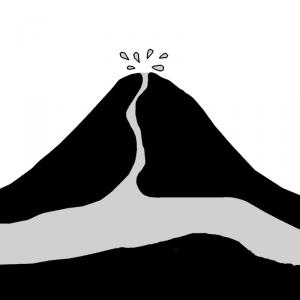When groundwater makes its way to the earth’s surface and emerges as small water holes or wet spots, this feature is referred to as a spring. The use of springs as the main source for community water supply is applicable whenever a spring occurs and its yield in terms of quantity and quality is sufficient. However, to maintain the water quality, protection of the spring in the catchment zone has to be ensured permanently to avoid contamination. Although springs only need little operation and maintenance, monitoring of water quality has to be conducted regularly.
| Entradas | Salidas |
|---|---|
Freshwater, Drinking Water |
When groundwater makes its way to the earth’s surface and emerges as small water holes or wet spots, this feature is referred to either as a spring or as surface seepage. In contrast to surface water, groundwater is usually of higher water quality. Few manifestations of groundwater have yielded more interest than springs. In this context, springs were largely responsible for determining the sites of ancient settlements (MEULI & WEHRLE 2001). Nowadays, modern techniques allow the construction of deep drilled wells. Yet, springs are still an important groundwater source since they are easily accessible and usually provide clean drinking water (SMET & WIJK 2002).
In many rural areas, spring water is often accessed without having implemented adequate spring protection measures or having installed appropriate catchment systems. As a consequence the spring gets contaminated and water quality does not meet criteria for drinking water standards. A properly tapped spring can improve a communities’ water supply substantially if combined with adequate protection measures.
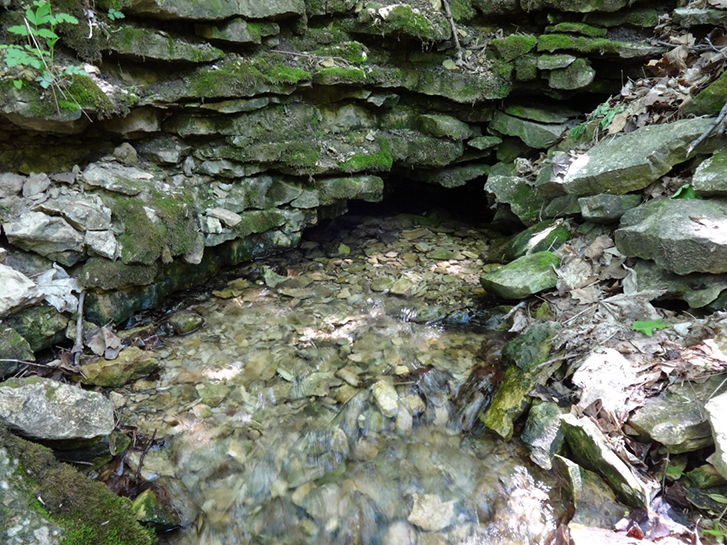
Adapted from SMET & WIJK (2002)
To understand the possibilities of water tapping from springs, the distinction between gravity springs and artesian springs is most important. In addition, the spring type with its underlying hydrogeological principle has implications on how the spring should be protected.
Gravity Depression Springs
Gravity springs occur in unconfined aquifers. Where the ground surface dips below the water table, any such depression will be filled with water. Gravity depression springs usually have a small yield and a further reduction occurs during the dry season or when nearby groundwater withdrawals result in the lowering of the groundwater table.

Gravity Overflow Springs
A larger and less variable yield from gravity springs is obtained where an outcrop of impervious soil, such as a solid or clay fault zone, prevents the downward flow of the groundwater and forces it up to the surface. Since the aquifer is not protected by an impervious layer above the discharge area, contaminants can easily enter the system and pollute the spring below. As for all gravity type springs, spring protection plays a vital role in ensuring safe drinking water supply.
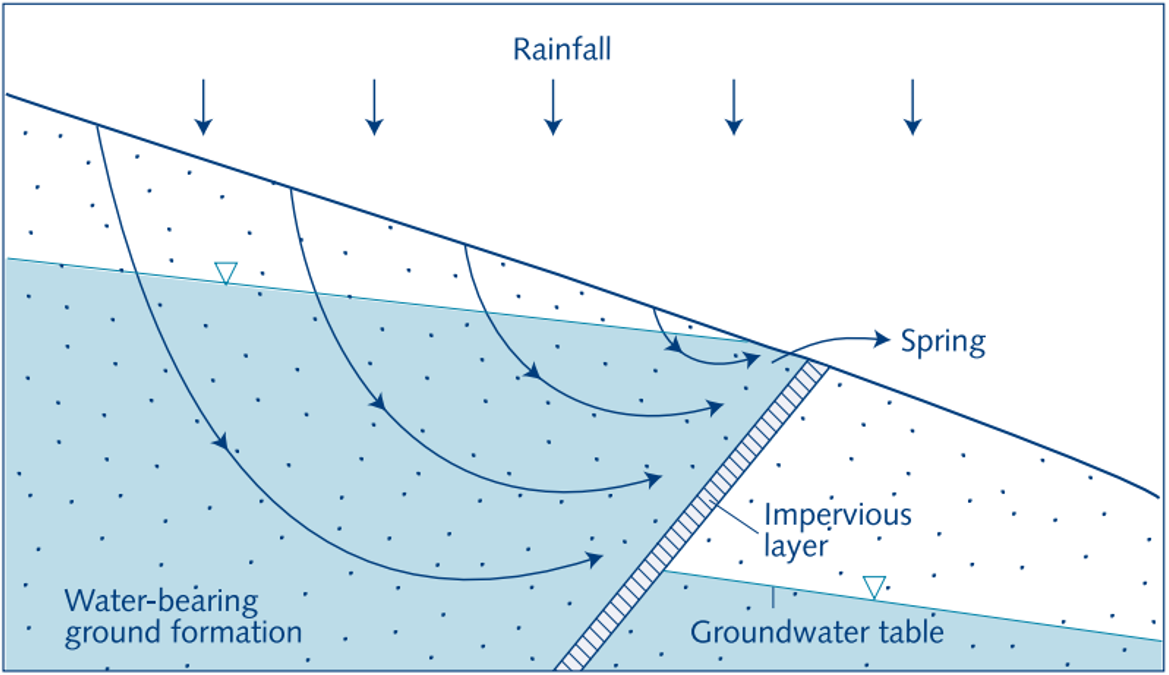
Artesian Springs
Artesian groundwater is prevented from rising to its free water table level by an overlaying impervious layer. It is under constant pressure and seeks its way to the surface. If cracks or fissures in the impervious layer are present, water is forced to flow through these openings until it reaches the surface where it forms an artesian spring.
Artesian springs often have remotely located and large recharge area. In terms of performance, discharge is usually considerable and shows little or no seasonal fluctuation. Moreover, the impervious cover protects the water in the aquifer against contamination. With these advantages, artesian springs can provide adequate water supply for small to large communities.
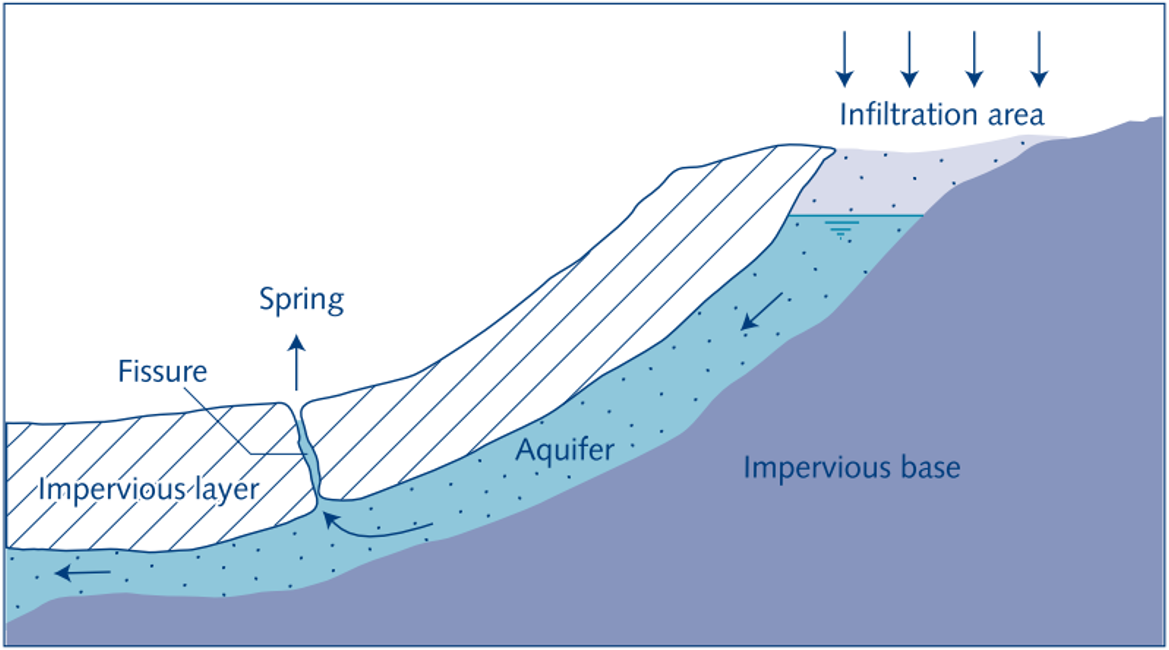
Tracing for springs requires much practical experience. The best places to look for springs are on the slopes of hillsides and river valleys. It is always advisable to investigate the source, which the villagers are already using for their water requirements. Villagers and people knowing the area (e.g. hunters, farmers, etc.) may provide information about potential new water sources. For more information on how to trace for springs, consult MEULI & WEHRLI 2001 pp.10.
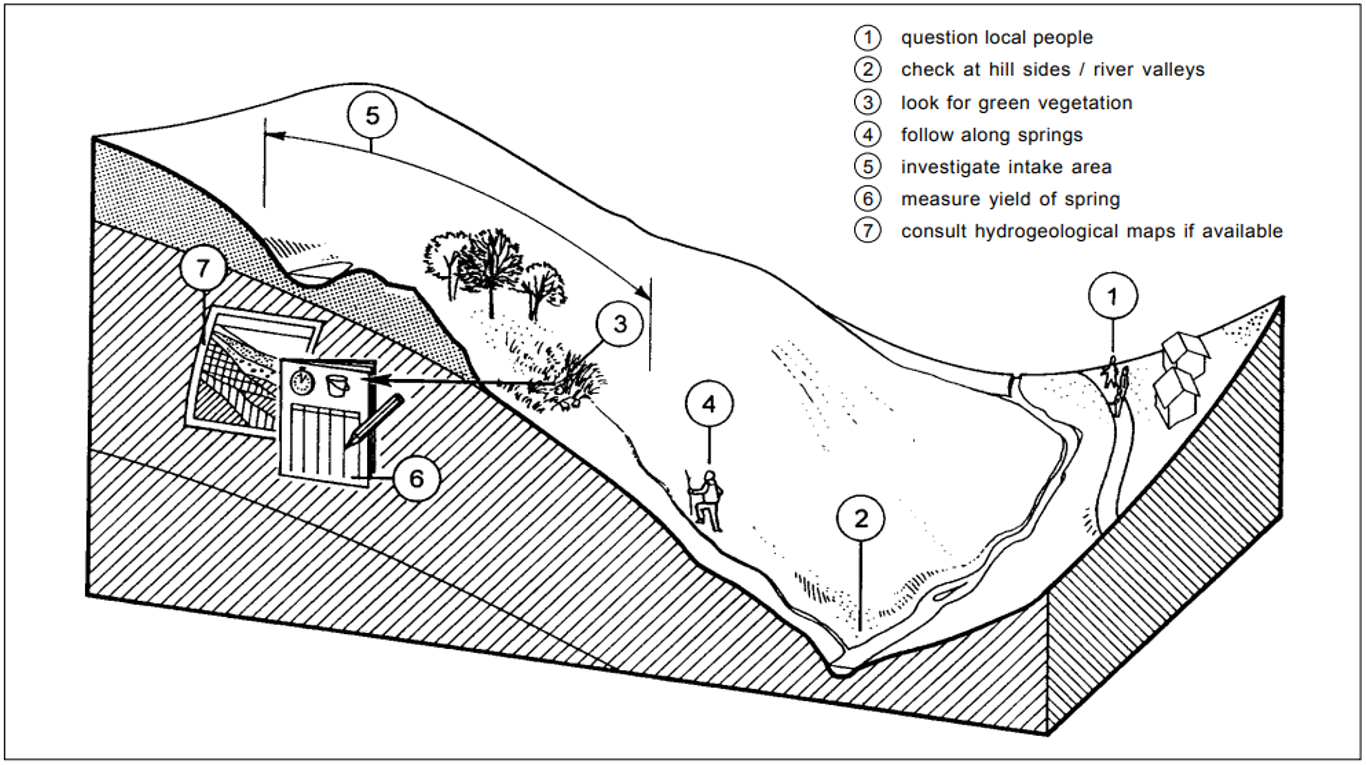
Having found a spring, its suitability as a drinking water source has to be assessed. The feasibility study provides the information and data for the design of a water supply system and if possible takes into consideration any possible environmental impact. Local people are important sources of information and should be involved in decisions about the feasibility of developing any particular spring (see also stakeholder analysis). Aspects to be considered include the quantity and quality of the water, its reliability (see also access to water and sanitation, the right to water and sanitation and waterborne diseases, pathogens & contaminants), current and future uses (see also water conflicts), and awareness raising (see PPT) for domestic water supply. A representative feasibility study is therefore best done together with a team of community members (SMET & WIJK 2002).
Before starting to design and develop any kind of water source, an initial assessment should be conducted in order to effectively and efficiently manage and develop water resources. This assessment includes a water balance estimation (i.e. the collection of hydrological data, determination of the current status and trends of water supply, an input-output-analysis, and a water and material flow analysis) and water resources assessment (i.e. the evaluation and systematic study of water resources in relation to human impact, e.g. demand evaluation, trend estimation, analysis of water use and quality). When analysing the demand side, water allocation issues play a vital role. Eventually, this assessment can lead to a water resources development plan describing the status, the management and future development of water resources in a particular area or watershed.
After having identified a feasible spring, construction of a spring catchment is required to make the source accessible. The involvement of the local population is very important to ensure that villagers identify with the project in the long term. However, very firm guidance from an experienced foreman or technician is required (MEULI & WEHRLI 2001). Once constructed and backfilled, the access to the collection area, for instance to correct errors, is very tedious. Thus, care and experience is needed for proper spring construction (SMET & WIJK 2002).The construction of a spring catchment often requires concrete structures and thus materials like cement, clean sand and gravel. Clearly, various pipes and construction tools are needed as well.
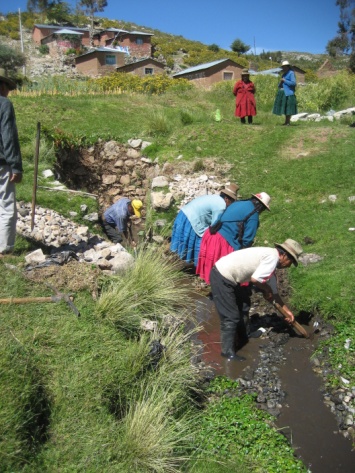
Gravity Springs
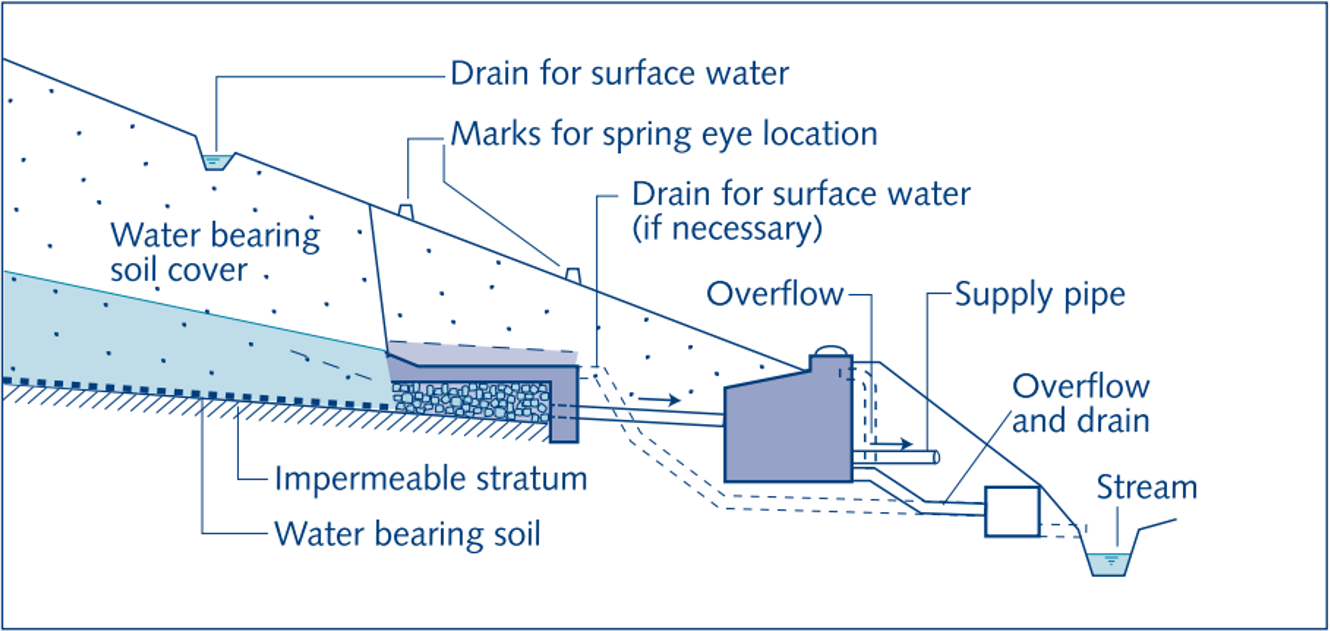
The major components in the design of a gravity spring water supply system include the actual spring water collection area – where water from the aquifer is actually being channelled to a single discharge point – the supply pipe, the collection chamber (or spring box), and the outlet to a storage tank. The collection area is a critical part and involves the tapping of water from the aquifer (SMET & WIJK 2002).
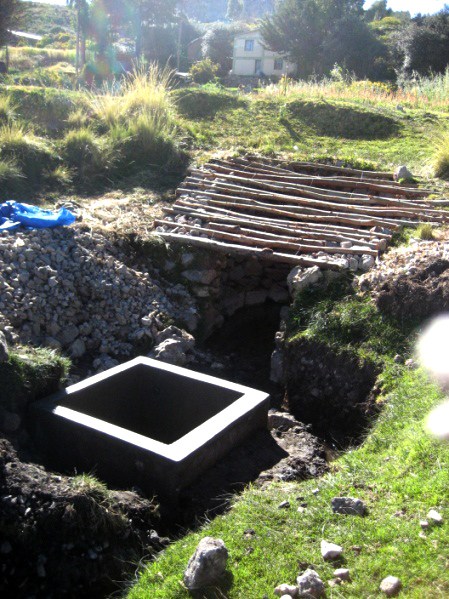
Although not always required, a spring box can provide many benefits. It protects the spring water from contamination by surface runoff, from contact with humans and animals, and acts as a sedimentation basin (WFTW, RWS.1.C.1). Yet, its particular advantage is the storage of water. If a spring has a low flow and is not able to meet peak demands during the day, it might still be sufficient for the needs of a community if allowed to accumulate over the course of a night and other time periods when not in use. Another advantage is that spring boxes may also act as settling basins, assisting the removal of suspended sediments. This is a distinct health advantage since bacteria and other organisms are generally attached to soil particles (HAWLEY 2003; WATERAID 2008).
Artesian Springs
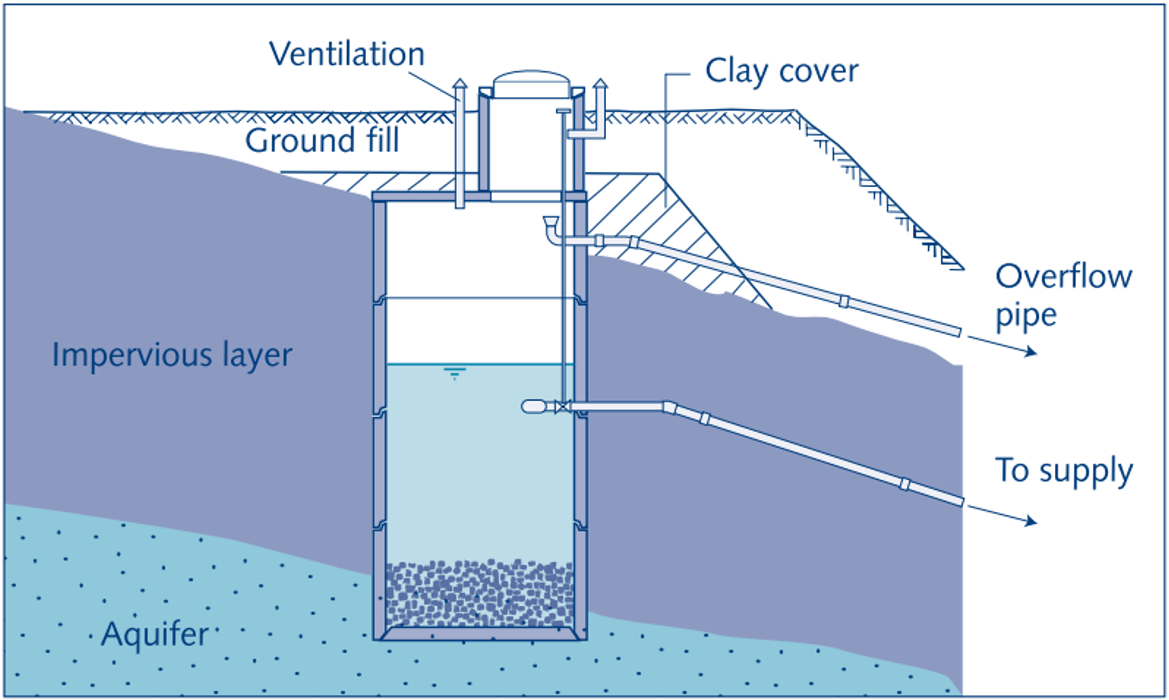
The tapping of artesian springs differs quite a bit from the tapping of gravity springs since the water flow is oriented vertically. The type of construction also depends on the size and the type of the ground (i.e. solid ground or soft soil) (MEULI & WEHRLI 2001). Many technical manuals can be found in the ‘training material’ section below.
Protection of the Catchment and the Spring Surrounding
In order to maintain safe drinking water quality, the permanent protection of the catchment and the direct spring surroundings is essential. The protection measures must be enforced and fully respected and understood by the local water users to guarantee long-term sustainability (see also water source protection). Protection not only prevents the contamination of the groundwater but also improves the recharge of the aquifer (WAARDE et al. n.y.).Follow the link for further information on water source protection.
Given that the spring is located close to and above the point of use, no complex distribution system or pumping is required. Since spring water quality is generally high, no or just minor purification measures are usually necessary. Springs thus have rather low construction and maintenance costs compared to most other drinking water sources (WATERAID 2008).
Spring water is usually safe from contaminants (i.e. pathogens, chemicals, metals), since groundwater is naturally filtered as it flows through the soil. Hence, spring water is generally safe for human consumption (HAWLEY 2003). Nevertheless, a spring box is usually installed acting as a sedimentation chamber. Special care has to be taken to the protection of springs to prevent contamination (natural or anthropogenic) to ensure safe drinking water quality in the long term. This includes an adequate management of agricultural activities (e.g. pesticides, dung), sanitation (faecal contamination), waste, etc. Additional (residual) chlorination may become necessary if spring water is distributed via a piped distribution system.
Adapted from MEULI & WEHRLI (2001)
Spring catchments need very little operation and a lot less maintenance than other catchment systems. A simple design combined with high-quality construction for all structures in the catchment area will keep maintenance requirements to a minimum. Nevertheless, all spring catchments need a periodic check-up. To ensure water quality and to avoid operational problems at the catchment, a monthly control is vital. Minor jobs like basic repairs or monitoring activities can be planned and carried out by the caretaker (HELVETAS n.y.). In case of major repairs (e.g. wet spots around the catchment, leaks at the spring chamber, etc.), the responsible service should be consulted.
The following aspects have to be checked during regular visits to the catchment area:
At the protection zone:
- The fence of the protection area.
- The diversion drainage above the catchment.
- Wet spots indicating a leakage from the catchment.
- Trespass such as prohibited farming in the intake area.
At the spring chamber:
- Leakage at the chamber
- The manhole cover
- Blockage at the supply line - water comes through the reserve (overflow) pipe
- The ventilation
- The water quality and quantity (tested without equipment)
- Sedimentation in the chamber
- If possible measure the yield of the spring and compare it with data of previous years
| Working Principle | A spring is formed when groundwater naturally emerges at the surface. The water can be collected, stored and used for various purposes depending on the water quality and quantity. |
| Capacity/Adequacy | Depending on its performance, a spring can provide adequate drinking water for small rural communities as well as for urban areas. |
| Performance | Gravity type: performance depends on rainfall patterns Artesian type: usually high performance |
| Costs | Low for both construction and O&M if pumping is not required. |
| Self-help Compatibility | Experienced technician required for design and assistance of construction. O&M can easily be carried out by a local caretaker. |
| O&M | Very little O&M required |
| Reliability | Gravity type: seasonal variability possible Artesian type: usually high reliability |
| Main strength | High water quality |
| Main weakness | Springs only occur under specific hydrogeological conditions. |
The use of springs as the main source for community water supply is applicable whenever a spring occurs and its yield in terms of quantity and its quality is sufficient. However, to maintain water quality, strict protection of the spring in the catchment zone has to be ensured permanently to avoid contamination. Although springs only need little operation and maintenance, monitoring of water quality has to be conducted regularly. In many cultures, springs are highly respected as a kind of sacred spot or as a dwelling place of spirits. This attitude and belief towards springs needs to be carefully considered when constructing a spring catchment (MEULI & WEHRLE 2001).
A Technical Brief for Springbox Construction
This document provides a detailed instruction on how to construct a spring box. It also covers material requirements and operation and maintenance issues.
HAWLEY, R.J. (2003): A Technical Brief for Springbox Construction. Houghton: Michigan Technological University URL [Visita: 12.03.2011]Village Water Supply. Caretakers Manual
In several modules and lessons, this course lists all the tasks of a caretaker, introduces conflict management, explains maintenance issues related to village water supply schemes (VWSS) and covers conceptual topics of VWSS’s (Planning, Implementation, Monitoring and Evaluation).
HELVETAS (n.y): Village Water Supply. Caretakers Manual. Bamenda: Helvetas Cameroon PDFSpring Catchment
This highly recommended publication comprises everything regarding the establishment of a spring-based water supply system. It elaborates on the underlying hydrogeological principles, preparatory investigations, design, construction, operation and maintenance, and it discusses the most common mistakes made on spring catchments.
MEULI, C. WEHRLE, K. (2001): Spring Catchment. (= Series of Manuals on Drinking Water Supply , 4 ). St. Gallen: Swiss Centre for Development Cooperation in Technology and Management (SKAT) URL [Visita: 08.03.2019] PDFSmall Community Water Supplies: Technology, People and Partnership: Spring Water Tapping - Chapter 8
This book provides a general introduction to a wide range of technologies. Among the topics covered are: planning and management of small water supplies, community water supplies in Central and Eastern European countries, water quality and quantity, integrated water resources management, artificial recharge, rainwater harvesting, spring water tapping, groundwater withdrawal, water lifting, surface water intake, water treatment, aeration, coagulation and flocculation, sedimentation, multi-stage filtration, desalination technology, disinfection, household level water treatment, technologies for arsenic and iron removal from ground water, and emergency and disaster water supply.
SMET, J. ; WIJK, C. van (2002): Small Community Water Supplies: Technology, People and Partnership: Spring Water Tapping - Chapter 8. The Hague: International Water and Sanitation Centre (IRC), pp. 151-168. URL [Visita: 08.03.2019] PDFWater Catchment Protection Handbook
This document provided by Helvetas Cameroon describes an approach for the organisational and technical implementation of water catchment protection. This approach consists of 8 steps including sensitisation, feasibility studies, protection plans, land ownership, implementation, O&M, monitoring, and evaluation. This step-wise approach can be used as a guideline for implementing water catchment activities in village water supply systems.
WAARDE, J. van der MUSA, T.M. ISCHER, M. (n.y): Water Catchment Protection Handbook. (= Learning and Experience Sharing Series , 1 ). Bamenda: Helvetas Cameroon, Swiss Association for International Co-operation URL [Visita: 08.03.2019] PDFTechnology Notes
These technology notes have been prepared following many general enquiries for technical information having been received by WaterAid over the years. Their purpose is to give an outline of the technologies used by WaterAid on long-term development projects in Africa and Asia, and to show alternatives, which might be appropriate in different circumstances. It may be possible to determine from the notes the technology, which would be appropriate in a particular location.
WATERAID (2008): Technology Notes. London: WaterAid URL [Visita: 04.01.2011] PDFSpring Catchment and Spring Box
Constructing Structures for Springs. Technical Note No. RWS. 1.C.1.
This technical note discusses the construction of spring boxes and collection systems, and outlines further construction steps.
WFTW (n.y): Constructing Structures for Springs. Technical Note No. RWS. 1.C.1.. Washington, D.C.: Water for the World (WFTW), U.S. Agency for International Development URL [Visita: 08.03.2019] PDFSpring Catchment
This highly recommended publication comprises everything regarding the establishment of a spring-based water supply system. It elaborates on the underlying hydrogeological principles, preparatory investigations, design, construction, operation and maintenance, and it discusses the most common mistakes made on spring catchments.
MEULI, C. WEHRLE, K. (2001): Spring Catchment. (= Series of Manuals on Drinking Water Supply , 4 ). St. Gallen: Swiss Centre for Development Cooperation in Technology and Management (SKAT) URL [Visita: 08.03.2019] PDFSmall Community Water Supplies: Technology, People and Partnership: Spring Water Tapping - Chapter 8
This book provides a general introduction to a wide range of technologies. Among the topics covered are: planning and management of small water supplies, community water supplies in Central and Eastern European countries, water quality and quantity, integrated water resources management, artificial recharge, rainwater harvesting, spring water tapping, groundwater withdrawal, water lifting, surface water intake, water treatment, aeration, coagulation and flocculation, sedimentation, multi-stage filtration, desalination technology, disinfection, household level water treatment, technologies for arsenic and iron removal from ground water, and emergency and disaster water supply.
SMET, J. ; WIJK, C. van (2002): Small Community Water Supplies: Technology, People and Partnership: Spring Water Tapping - Chapter 8. The Hague: International Water and Sanitation Centre (IRC), pp. 151-168. URL [Visita: 08.03.2019] PDFA Technical Brief for Springbox Construction
This document provides a detailed instruction on how to construct a spring box. It also covers material requirements and operation and maintenance issues.
HAWLEY, R.J. (2003): A Technical Brief for Springbox Construction. Houghton: Michigan Technological University URL [Visita: 12.03.2011]Protecting Springs – An Alternative to Spring Boxes
The construction of a spring box is both complex and costly. However, it may not be necessary at all. This short publication suggests an alternative construction to a conventional spring box.
SKINNER, B. SHAW, R. (n.y): Protecting Springs – An Alternative to Spring Boxes. (= Running Water , 34 ). Leicestershire: Water, Engineering and Development Centre (WEDC), Loughborough University URL [Visita: 08.03.2019] PDFTechnology Notes
These technology notes have been prepared following many general enquiries for technical information having been received by WaterAid over the years. Their purpose is to give an outline of the technologies used by WaterAid on long-term development projects in Africa and Asia, and to show alternatives, which might be appropriate in different circumstances. It may be possible to determine from the notes the technology, which would be appropriate in a particular location.
WATERAID (2008): Technology Notes. London: WaterAid URL [Visita: 04.01.2011] PDFSelecting a Source of Surface Water. Technical Note No. RWS. 1.P.3
This technical note suggests guidelines for choosing the most appropriate surface water source for a community. It describes methods for measuring the quantity of water available from a surface source, and establishes four priorities for source selection.
WFTW (n.y): Selecting a Source of Surface Water. Technical Note No. RWS. 1.P.3. Washington, D.C.: Water for the World (WFTW), U.S. Agency for International Development URL [Visita: 08.03.2019] PDFSpring Improvement as a Tool for Prevention of Water-related Illnesses in Four Villages of a Province of Cameroon. A Report
This paper covers four spring improvement projects serving a total of 1,306 residents in four villages, conducted during two years in the Center Province of Cameroon.
FRY, L. (2004): Spring Improvement as a Tool for Prevention of Water-related Illnesses in Four Villages of a Province of Cameroon. A Report. Houghton: Michigan Technological University URL [Visita: 12.03.2011]Construction of Improved Community Spring for Clean Drinking Water in Rural Peru
A short description of a spring improvement project conducted in Peru in 2011. The case study nicely links the project to the global context, elaborates on the methodology of the project and provides a detailed list of the costs for the construction of a spring box.
GUNTHER, K. (2011): Construction of Improved Community Spring for Clean Drinking Water in Rural Peru. Puno: Loma Lina University School of Public Health URL [Visita: 12.03.2011]Village Water Supply. Caretakers Manual
In several modules and lessons, this course lists all the tasks of a caretaker, introduces conflict management, explains maintenance issues related to village water supply schemes (VWSS) and covers conceptual topics of VWSS’s (Planning, Implementation, Monitoring and Evaluation).
HELVETAS (n.y): Village Water Supply. Caretakers Manual. Bamenda: Helvetas Cameroon PDFConstructing Structures for Springs. Technical Note No. RWS. 1.C.1.
This technical note discusses the construction of spring boxes and collection systems, and outlines further construction steps.
WFTW (n.y): Constructing Structures for Springs. Technical Note No. RWS. 1.C.1.. Washington, D.C.: Water for the World (WFTW), U.S. Agency for International Development URL [Visita: 08.03.2019] PDFMaintaining Structures for Springs. Technical Note No. RWS. 1.0.1
This report describes the periodic maintenance needed for spring boxes and seep collection systems to make them operate effectively in the long-term.
WFTW (n.y): Maintaining Structures for Springs. Technical Note No. RWS. 1.0.1. Washington, D.C.: Water for the World (WFTW), U.S. Agency for International Development URL [Visita: 08.03.2019] PDFPlanning How to Use Sources of Surface Water. Technical Note No. RWS. 1.P.1
This technical note describes the planning needed to use surface water (as well as spring water) sources in terms of various planning steps: recognising the problem, organising community support, setting objectives, etc.
WFTW (n.y): Planning How to Use Sources of Surface Water. Technical Note No. RWS. 1.P.1. Washington, D.C: Water for the World (WFTW), U.S. Agency for International Development URL [Visita: 08.03.2019] PDFSpring catchment - using PVC tubes
This EMAS movie shows how to cap a spring using PVC tubes. Spring catchment needs to be carried out with great care, as there is often a risk of stopping the water flow if the layer is disturbed too much, for example when digging too deep.
Spring catchment - combined with long-distance pumping
This movie shows how to combine a spring with an EMAS pump, which pumps the water over a larger distance.
Water supply in small communities
This website describes step-by-step how water supply in small communities should be implemented.



